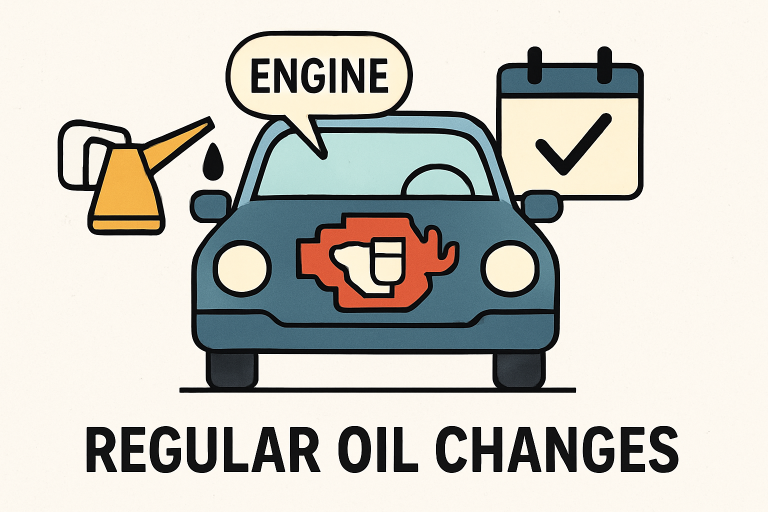Table of Contents
What Happens If You Skip Oil Changes?
Engine oil operates as the essential lubricant for all the fast-moving components inside your car’s engine, preventing overheating and reducing friction. When regular oil changes are skipped, oil degrades and becomes thick with contaminants, losing its lubricating power. This leads to increased wear on engine components and can ultimately result in catastrophic engine failure.
Maintaining a proper oil change routine is not just about prolonging the life of your engine—it’s about avoiding preventable, costly repairs. For drivers of any make, especially those considering a Toyota oil change at a certified service center, following the outlined service intervals offers peace of mind and long-term savings. Regular oil changes also help improve your vehicle’s fuel efficiency. They ensure your engine operates smoothly by reducing friction and wear. Additionally, staying on schedule with oil changes can help identify potential issues early, saving you money and preventing breakdowns.
Reasons Why Oil Changes Matter
- Friction reduction: Clean oil forms a protective film on engine parts, minimizing wear from friction.
- Temperature control: Oil carries heat away from vital engine parts, preventing overheating.
- Engine cleanliness: Oil continuously traps dust, metal shavings, and sludge, keeping the engine internals clean.
- Improved efficiency: Well-lubricated parts work smoothly, which can mean better MPGs and lower emissions.
Failing to replace old, dirty oil results in increased friction, heat, and the build-up of sludge—a combination that directly affects engine efficiency and longevity. According to Edmunds’ guidelines about oil change intervals, neglecting oil changes increases engine stress, which ultimately leads to more costly repairs or even engine replacement.
To maintain consistent performance and reliability, every vehicle needs an oil change that aligns with the manufacturer’s guidelines. If you ever wonder, “Where’s a Toyota dealership near me that can help?” choosing a certified center ensures expert care using the right oil for your vehicle.

Different Types of Oil and How They Work
Choosing the right oil is vital for engine health. There are several types to consider:
- Conventional Oil: The classic option for most older vehicles, this oil is budget-friendly but requires more frequent changes.
- Synthetic Oil: Designed for higher performance, synthetic oil offers superior protection at extreme temperatures, enhanced cleaning properties, and can extend the time between changes. It’s ideal for newer vehicles or those driven under harsher conditions.
- Synthetic Blend: Combining both conventional and synthetic oils, blends offer a balance of protection and affordability. These are a good choice for drivers seeking better performance without the higher cost of full synthetic.
For the best results, always check your vehicle’s owner’s manual or consult with a qualified technician to determine which type of oil suits your specific driving habits and vehicle requirements. Using the manufacturer-recommended oil ensures optimal engine protection and efficiency.
When to Change Your Oil: Signs to Watch For
- Warning lights or dashboard indicators, such as “check oil,” become illuminated
- The engine is noisier than usual, or you hear knocking sounds
- Oil looks thick, dark, or gritty on the dipstick
- Mileage or months since your last change exceed what’s listed in your maintenance schedule
Modern vehicles often come with oil life monitoring systems that gauge oil condition by analyzing various driving factors. However, don’t ignore visual inspections—checking your oil regularly is a simple step that helps prevent major issues and ensures you don’t miss an overdue change.
Steps for a Proper Oil Change
- Gather all supplies: manufacturer-recommended oil, a quality oil filter, wrench, oil pan, and gloves.
- Warm the engine briefly to thin the oil, allowing it to drain more efficiently.
- Turn off the engine and let it cool slightly before you start.
- Remove the drain plug and allow the old oil to fully drain into a pan.
- Replace and tighten the drain plug and install a new oil filter.
- Pour in new oil, checking the dipstick to ensure the right level and type has been added.
- Run the engine and check for leaks, then recheck the oil level, topping off as needed.
Properly disposing of used oil is essential. Never pour it down the drain or on the ground—bring it to a local auto shop or recycling center. According to the EPA’s used oil management guide, responsible disposal protects the community and the environment.
Cost-Saving Tips for Routine Oil Changes
Managing your vehicle’s maintenance costs is possible with a few simple strategies:
- Search for discounts, coupons, or join loyalty programs at your preferred service center.
- If you perform oil changes yourself, buy oil and filters in bulk during sales for long-term savings.
- Don’t change oil more frequently than needed—follow your car’s schedule to avoid waste.
- Combine oil changes with other routine services to spot potential issues early, preventing major repairs down the road.
Following vehicle-specific recommendations, as reinforced by Consumer Reports, helps you tailor oil change intervals that suit your driving conditions, further managing costs.
Long-Term Benefits of Routine Maintenance
Vehicles treated to regular oil changes tend to see fewer breakdowns and significantly reduced engine wear. This simple habit is one of the most cost-effective ways to ensure your car reliably lasts for years, often well beyond 200,000 miles. It also supports a better resale value and reduces the chance of being stranded due to unexpected engine issues.
Owners who commit to on-time maintenance, including scheduled oil changes, often save thousands in potential repairs and enjoy smoother, more efficient driving throughout their vehicle’s life.
Conclusion
Routine oil changes are one of the simplest yet most effective ways to protect your engine and extend the life of your vehicle. Fresh oil keeps components properly lubricated, reduces wear, and improves overall performance while preventing costly repairs down the road. By staying consistent with oil change schedules, drivers can enjoy smoother rides, better fuel efficiency, and the peace of mind that comes with a well-maintained engine.




